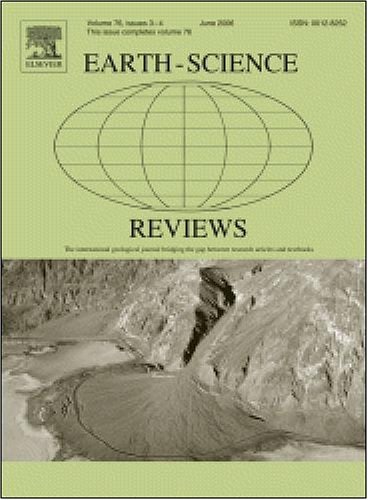地震诱发的海底滑坡(EQISLs)及其与陆地滑坡的比较:来自新数据库的见解
IF 10.8
1区 地球科学
Q1 GEOSCIENCES, MULTIDISCIPLINARY
引用次数: 0
摘要
地震被认为是海底滑坡的主要原因。这些由地震引起的海底滑坡会破坏海底基础设施(如海底电缆、输油管道和钻井平台),并引发不能仅用同震变形来解释的异常海啸。然而,由于地震诱发的海底滑坡发生在水下,因此很难直接观测和测量,与地震诱发的陆地滑坡相比,目前对其特征和触发机制的了解仍然有限。地震后发生的异常海啸和海底电缆断裂的历史实例为地震引起的海底滑坡提供了宝贵的见解。本研究利用美国国家海洋和大气管理局海啸数据库和系统的文献综述,回顾了自1900年以来全球124次地震后发生的异常海啸和海底电缆断裂事件。该研究编制了与异常海啸和海底电缆断裂相关的地震诱发海底滑坡的关键参数,如位置、头崖初始水深、平均海底坡度、体积和滑坡类型。本研究还从USGS-ShakeMap中获取了震中距离、峰值地面加速度(PGA)和修正Mercalli烈度(MMI)等地震参数,建立了地震诱发海底滑坡与其地震触发参数之间的定量关系。此外,比较了地震诱发的海底滑坡与地震诱发的陆地滑坡在滑坡参数、地震震级、地震参数PGA和MMI、地震震级-最大震中距离关系和触发机制等方面的异同。地震诱发的海底滑坡多发生在浅海近岸地区,并产生局地波高较高的海啸。这个属性几乎没有给警告和预防措施留下时间。具有陆上震中的地震或触发海底滑坡海啸的走滑机制对早期预警系统构成了额外的挑战。与地震诱发的陆地滑坡相比,地震诱发的海底滑坡通常发生在较平缓的斜坡上,体积较大,地震震级较小,触发机制也不同。然而,它们显示出比先前预期更多的相似之处,特别是在地震参数(PGA和MMI)和震源机制方面。研究结果有助于更好地理解地震诱发的海底滑坡特征及其与地震参数的定量关系。它强调了进一步研究地震后异常海啸和海底电缆断裂的必要性,以提高目前对地震引起的海底滑坡的触发机制、频率和潜在危害的理解。此外,考虑到地震诱发的海底滑坡和地震诱发的陆地滑坡的研究都是在一个统一的框架内探讨相互关联的科学问题,本研究强调了在地震诱发的地质灾害研究中比较海底和陆地环境的重要性。本文章由计算机程序翻译,如有差异,请以英文原文为准。
Earthquake-induced Submarine Landslides (EQISLs) and a comparison with their Terrestrial Counterparts: Insights from a New Database
Earthquakes are recognized as the primary cause of submarine landslides. These earthquake-induced submarine landslides can damage seafloor infrastructure (e.g. submarine cables, oil pipes and rigs) and trigger anomalous tsunamis that cannot be explained solely by coseismic deformation. However, due to their underwater occurrence, earthquake-induced submarine landslides are difficult to observe and measure directly, and current understanding of their characteristics and triggering mechanisms remains limited compared to earthquake-induced terrestrial landslides. Historical instances of anomalous tsunamis and submarine cable breaks following earthquakes provide valuable insights into earthquake-induced submarine landslides. This study reviewed 124 global events of anomalous tsunamis and submarine cable breaks following earthquake occurrences since 1900 using the National Oceanic and Atmospheric Administration tsunami database and systematic literature review. The study compiled key parameters of earthquake-induced submarine landslides associated with anomalous tsunamis and submarine cable breaks, such as locations, initial water depths of the headscarp, average seabed slope angles, volumes and landslide types. This study also obtained seismic parameters such as epicentral distances, peak ground acceleration (PGA) and Modified Mercalli Intensity (MMI) from the USGS-ShakeMap to establish a quantitative relationship between earthquake-induced submarine landslides and their seismic triggering parameters. Additionally, a comparison was made between earthquake-induced submarine landslides and earthquake-induced terrestrial landslides with emphasis on differences and similarities in landslide parameters, earthquake magnitudes, seismic parameters PGA and MMI, earthquake magnitude-maximum epicentral distance relationships and triggering mechanisms. It was observed that most of the earthquake-induced submarine landslides occur in shallow nearshore areas and generate tsunamis characterized by high local wave heights. This attribute leaves little or no time for warning and preventive measures. Earthquakes with onshore epicenters or strike-slip mechanisms that trigger submarine landslide tsunamis pose an additional challenge for early warning systems. Compared to earthquake-induced terrestrial landslides, earthquake-induced submarine landslides typically occur on gentler slopes, have larger volumes, are triggered by smaller earthquake magnitudes and exhibit distinct triggering mechanisms. However, they show more similarities than previously anticipated, particularly in terms of seismic parameters (PGA and MMI) and focal mechanisms. The findings of this study contribute to a better understanding of earthquake-induced submarine landslide characteristics and their quantitative relationship with seismic parameters. It highlights the necessity for further research on anomalous tsunamis and submarine cable breaks following earthquakes in order to improve current understanding of triggering mechanisms, frequencies and hazard potential of earthquake-induced submarine landslides. Moreover, given that studies on both earthquake-induced submarine landslides and earthquake-induced terrestrial landslides explore interconnected scientific questions within a unified framework, this study emphasizes the importance of comparing submarine and terrestrial environments in earthquake-induced geological disaster research.
求助全文
通过发布文献求助,成功后即可免费获取论文全文。
去求助
来源期刊

Earth-Science Reviews
地学-地球科学综合
CiteScore
21.70
自引率
5.80%
发文量
294
审稿时长
15.1 weeks
期刊介绍:
Covering a much wider field than the usual specialist journals, Earth Science Reviews publishes review articles dealing with all aspects of Earth Sciences, and is an important vehicle for allowing readers to see their particular interest related to the Earth Sciences as a whole.
 求助内容:
求助内容: 应助结果提醒方式:
应助结果提醒方式:


